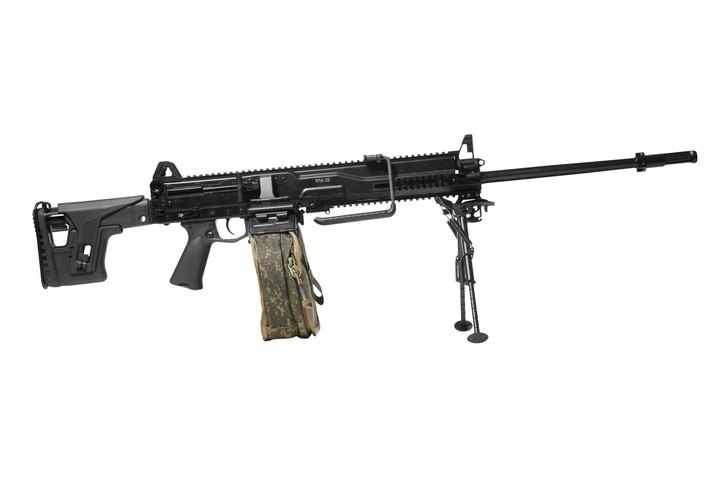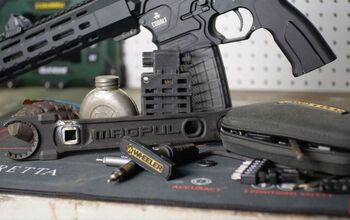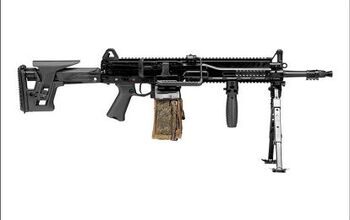The Russian RPL-20 Light Machine Gun

The RPL-20, a lightweight, belt-fed machine gun, is a testament to Russia's renewed interest in earlier Soviet technological innovations. The history of belt-fed light machine guns at the Kalashnikov Concern can be traced back to 1971 with the introduction of models such as the PU, PU-2, and PU-21. Drawing inspiration from the Belgian Minimi, these earlier models aimed to increase the RPK’s firepower. However, the dual-feed system has since been eliminated, simplifying manufacturing and enhancing the weapon's reliability. The RPL-20, with its lightweight design, is a promising addition to this lineage.
Kalashnikov Concern @ TFB:
The RPL-20, first unveiled at the ARMY Forum 2020, is a testament to Russia's commitment to innovation. Influenced by the PKM, it boasts a unique feature that sets it apart: the ability to accommodate a wide range of optical devices, enhancing its adaptability in diverse combat scenarios. The operating system was ingeniously rotated 180 degrees, with the feed assembly placed at the weapon's bottom and the piston assembly above the barrel, akin to an AK. Unlike the PKM's two-stage feed system, the RPL-20 utilizes a push-through belt system, a significant departure in design. This approach provides ample space for mounting various optics and accessories, showcasing the RPL-20's adaptability.
The RPL-20's construction is a testament to its durability and reliability. It features a stamped sheet metal receiver, which includes a top-positioned feed paw stamping. This design choice, in contrast to the PKM, where this feature is located underneath the weapon and obscured by the ammunition box mounting bracket, ensures the RPL-20's robustness and longevity.
The RPL-20 utilizes an ejection port actuator, with the securing bar prominently displayed on the left side of the weapon. As the bolt transitions between the rearward or forward, it opens the ejection port. The gun is designed to feed from the right side, utilizing new 5.45x39mm belts designed for push-through feeding. In contrast to most conventional belt-fed Western weapons, the RPL-20's belts are configured with brass oriented upwards, resulting in the open slot of the belt being positioned in an upward direction. This design enables the bottom of the bolt to extract the cartridge from the belt, unlike the traditional top of the bolt to strip a cartridge.
Regarding mounting options, the RPL-20 has an aluminum rail system with a continuous full-length top M1913 rail, which integrates both the rear fixed sight and a front flip-up sight. Furthermore, there are short sections at the 6 and 9 o’clock positions that appear to conform to the M-LOK standard and a more extended 6 o’clock section of M1913.
The barrel attachment of the RPL-20 features mission-configurable barrels, a feature that enhances the weapon's versatility and adaptability to different combat scenarios. These barrels are not designed for quick changes; they are interchangeable and can be configured for short or long configurations, depending on the mission requirements. This was the same design approach taken with the RPK-16.
Two mounting locations for the bipod have been added, one on the front of the receiver and the second just behind the muzzle device. This gives the operator options to fit their barrel length and role needs. The weapon's front trunnion is positioned just before the ammunition box mounting bracket. Just forward of the trunnion is the barrel mounting block, which includes a cross bolt that engages with a half-circular cutout on the barrel to secure it in place.
A barrel change lever on the left side of the weapon indicates whether the slotted barrel locking pin is rotated to unlock or if a rotating pin must be removed entirely to detach the barrel. The short and long barrels are lightweight, with the long barrel being exceptionally light. This design minimizes rapid fire and makes it comparable to the Knight Armament Light Assault Machine Gun. Though this is not a critical drawback, it is noteworthy that most combat engagements involving a light machine gun do not necessitate barrel changes.
The weapon does not incorporate a conventional feed tray; instead, it is engineered to utilize non-disintegrating belts of 100 and 200 rounds, which include a starter tab to facilitate feeding through the mechanism. This feeding system closely resembles that of the HK-21 machine gun. A notable feature of the RPL-20's design is its feed tray, operated via a release button behind the pistol grip, allowing for the opening of the feed tray cover. This mechanism is integrated into the fire control group, which tilts downward.
The safety mechanism is affixed to the receiver, enabling it to potentially secure the bolt in either the forward or rearward position. In a domestic context, this feeding method appears to be a simplified iteration of the OTs-124 Alatau feeding system, wherein the feed tray, equipped with a bullet guide, is connected to the ammunition box. However, in contrast to the OTs-124, the RPL-20 is chambered for the standard 5.45x39mm cartridge.
The Degtyarov factory ZID, located in Kovrov, is also developing additional 5.45x39mm light belt-fed machine guns, such as the KORD 5.45, which features a dual feed system capable of accommodating magazines and belts. This system exemplifies another Russian innovation, incorporating a gas tube above the barrel and omitting a traditional feed tray cover assembly. It employs new 5.45x39mm push-through non-disintegrating links in 25-round sections that can be interconnected or configured into 100-round continuous belts. These belts appear to be significantly smaller versions of NSV belts, and based on promotional materials released by ZID, they do not appear to be compatible with the RPL-20. This development is part of an ongoing prototype phase, and the weapon has yet to achieve standard adoption or formal standardization.
Recent advancements in the light machine gun have been presented at the ARMY Forums in recent years. The primary objective of these developments has been to reduce the overall weight of the weapon. This includes incorporating a top M1913 rail, effectively lowering the weapon's height. The light machine gun has an ambidextrous safety mechanism that offers safe and fire positions, facilitating a 180-degree throw. Furthermore, the right-side spring double hook charging handle has been repositioned to the rear of the receiver. According to the manufacturer, this design aims to minimize the risk of the operator's hand slipping off and is spring-loaded to mitigate potential damage to the charging handle. The charging handle features a ratcheting mechanism, which enhances safety by preventing negligent discharges if the handle is not fully racked.
Additionally, the weapon includes a folding stock mechanism akin to the AK-12 series, with the potential for compatibility with future AK-12 stock developments, as these components tend to evolve with each iteration. Current RPL-20 stats include an advertised weight of 11-12 lbs. (5.2-5.5 kg), a rate of fire of 600 rounds per minute, and an effective range of 800 meters.
Moving from a magazine-fed to a belt-fed light machine gun is a wise transition, significantly enhancing the weapon's firepower. As we can observe, Russia has nearly wholly replaced all RPK-74 light machine guns with PKM general-purpose machine guns, which was a strategic decision. This shift provides a distinct advantage in firepower and increased engagement ranges, thereby outmatching the current NATO countries' 5.56x45mm-based light machine gun.
The future of the RPL-20 remains uncertain, and it is unclear what will become of it. If the RPL-20 gains traction, it will most likely be utilized by police and security forces. We will need to monitor how this system develops and its fate.

Lynndon Schooler is an open-source weapons intelligence professional with a background as an infantryman in the US Army. His experience includes working as a gunsmith and production manager in firearm manufacturing, as well as serving as an armorer, consultant, and instructor in nonstandard weapons. His articles have been published in Small Arms Review and the Small Arms Defence Journal. https://www.instagram.com/lynndons
More by Lynndon Schooler


















![[SHOT 2025] Jacob Grey TWC Hex](https://cdn-fastly.thefirearmblog.com/media/2025/01/26/00051/shot-2025-jacob-grey-twc-hex.jpg?size=350x220)


![[SHOT 2025] Leupold Introduce The VX-6HD Gen 2 Riflescope Line](https://cdn-fastly.thefirearmblog.com/media/2025/01/23/10491/shot-2025-leupold-introduce-the-vx-6hd-gen-2-riflescope-line.jpg?size=350x220)


![[SHOT 2025] Hands-on With Maztech Systems](https://cdn-fastly.thefirearmblog.com/media/2025/01/23/10253/shot-2025-hands-on-with-maztech-systems.jpg?size=350x220)

Comments
Join the conversation
If the RPK-74s have been replaced by PKMs to improve punch and reach, does this mean the RPK-16 is out as well?
Interesting info. Thanks!